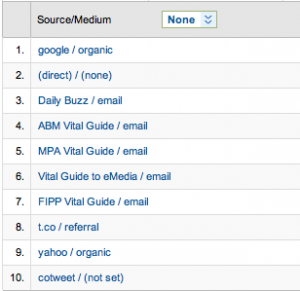Twitter recently made a tweak to its microblogging service that will help media companies better view how much traffic is coming to their site from tweets. Not only is this helpful for measuring social traffic, but it can also help you understand how well you’re optimizing your site to encourage sharing on Twitter.
The change is another example of Twitters constant platform updates we’ve been covering. Here’s how the recent fix can help you analyze and improve your organization’s social media strategy.
Viewing referral traffic more accurately
You might have noticed in your analytics that Twitter is listed as a much higher source of traffic than it was before. That’s because Twitter now consolidates all the traffic from Twitter and Twitter clients (e.g. CoTweet, TweetDeck) as one stat. In the past, Twitter would show each Twitter client separately, which made Twitter referral numbers fragmented. To make matters worse, some stats from Twitter would show up as direct traffic (one study found this is the case with more than half of clicks from Twitter).
At eMedia Vitals, our traffic sources from Twitter used to be numerous but now Google Analytics shows it as a single “t.co” domain (CoTweet is still listed separately, which I’ll explain next):
The move came about last week when Twitter began wrapping all links posted on Twitter.com or any Twitter client with the t.co domain. The Next Web offers a more detailed explanation of the Twitter changes and what it means for website owners.
Basically, media companies can more easily see exactly how much traffic is coming from Twitter. And it might be even more than you previously realized.
Evaluating your Twitter gameplan
Media companies can also use Twitter’s analytics to look at how their own tweets are doing. Doing so can provide a few more nuggets of insight to improve your social strategy.
At eMedia Vitals, for example, we will be looking at how well the tweets sent by the editorial staff bring in referral traffic compared to other tweets. In order to do this, we tag our tweets at the end with “?utm_source=cotweet” (“?utm_source=” is the code Google Analytics uses to differentiate traffic sources and “CoTweet” is the client our editors use to send tweets).
The stats are important because I want to know how much traffic the tweets I send create (in addition to how many retweets they generate). Twitter has become another form of content creation journalists need to measure and improve.
Optimizing your site for social sharing
Separating out editorial-driven tweets also allows media companies to see how much Twitter referral traffic was generated from visitors to your site (as opposed to from your own tweets). If you aren’t getting many tweets sent from your site, you might need to rethink how well pages are optimized to encourage users to tweet.
For example, is your tweet button usable and well-placed on the site? You can examine this by comparing the traffic numbers from Twitter referrals to the number of tweets sent from your tweet button. An outside provider like AddThis offers those numbers. If not many tweets are coming from the tweet button, it could mean there’s room for improvement in the site design.
It’s also worth noting that media companies who use a service such as AddThis are allowing the third party to collect audience data whenever users tweet — so, media companies are providing valuable information in exchange for using the free service. It’s important to look at the numbers to make sure you’re getting your money’s worth.
Have you found other ways to leverage Twitter analytics? Please share in the comments below.












